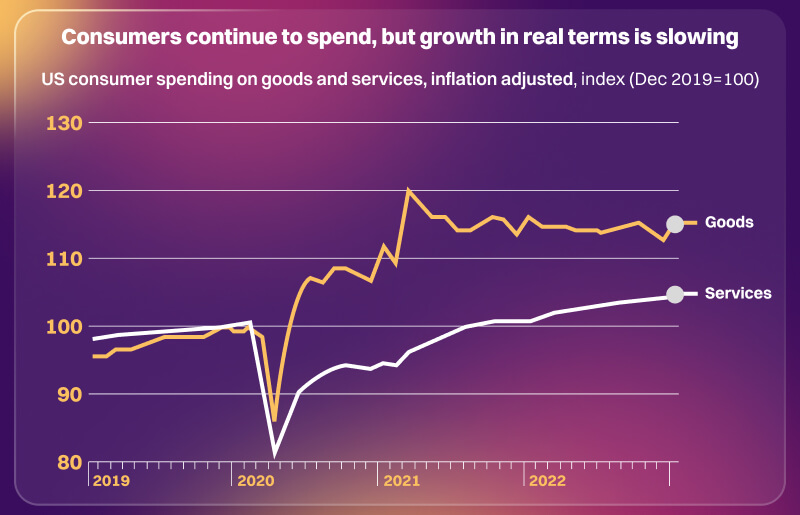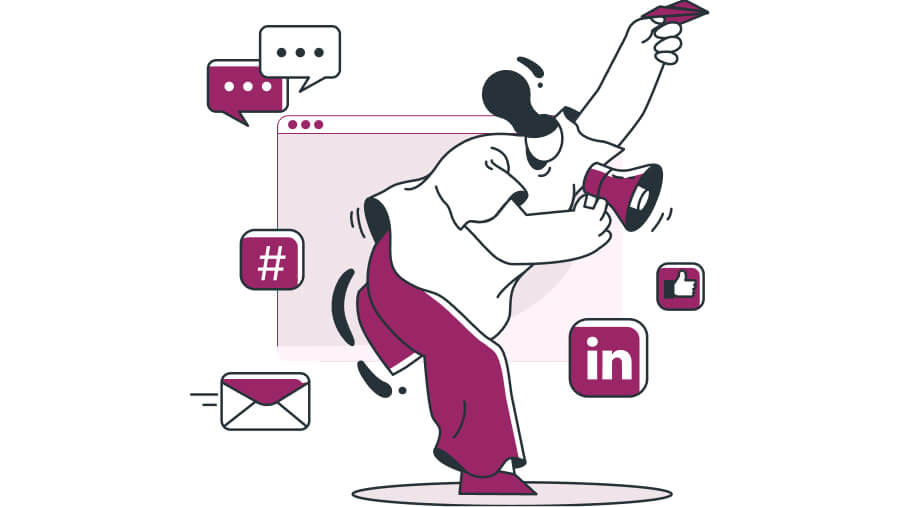
Social Media in Outbound Marketing: 8 Rebound Strategies
The economic for forecast 2024 has seen its fair share of turbulence – with the specter of a predicted recession casting a formidable shadow. As the business landscape recalibrates, it becomes necessary to maintain visibility and attract and retain customers fast. As such, a resilient outbound marketing strategy is critical.
Here's the deal: Soon, traditional marketing approaches may feel the strain. Why? Consumer behaviors will shift, preferences shall evolve, and economic uncertainties might linger.
According to McKinsey, consumers are worried about inflation. They're cutting costs by choosing cheaper brands and adjusting their purchases to save money. It is reflected in a slowdown in their spending on goods – as shown below:

This is where social media enters as a dynamic force. In 2023, social media ad spending reached around $270 billion, poised to exceed $300 billion by 2024. These numbers alone are a testament to its transformative power.
Your audience is more discerning, resource-conscious, and digitally savvy. And here, social media becomes a valuable asset in outbound marketing. Why? It can reach a discerning, cost-conscious, and digitally savvy audience, fostering quick decision-making.
So, how do you integrate this trend into your B2B campaigns? Here are eight proven tips!
8 Strategies to Harness Social Media for Post-Recession Outbound Marketing
Here’s a rundown of our eight tactics to embed social media in your outbound marketing campaigns – to revolutionize how you connect, engage, and triumph in the post-recession landscape.
1. Strategize Your Social Media Messaging
Customize your messages to resonate with the economic climate. Statistics show that 78% of consumers consider social media influential when purchasing. So, emphasize value propositions and align them with your client’s financial priorities. Here are a few examples:
- Cost Savings: Highlight discounts, promotions, or budget-friendly packages to showcase immediate monetary benefits for customers.
- Quality and Longevity: Emphasize a product's or service's durability and long-term value, reassuring customers of a wise investment.
- Flexible Payment Options: Offer installment plans or flexible payment structures to ease financial burdens and make purchases more accessible.
- Exclusive Deals for Loyal Customers: Reward customer loyalty with exclusive discounts or perks, fostering a sense of appreciation and value.
- Sustainability Benefits: Promote eco-friendly practices, emphasizing low- low-environmental impact products, and aligning with conscious consumerism trends.
- Time Efficiency: Showcase how a product or service can save time and effort, increasing productivity and potentially reducing overall expenses.
2. Create Engagement-driven Content
Engagement-driven content helps promptly capture your audience’s attention. Here are some examples of such content types:
- Interactive content, such as quizzes or polls, captures attention instantly (as recognized by 81% of consumers). Plus, it encourages active participation.
- Additionally, user-generated content (UGC) is yet another tool to foster trust and authenticity – trusted by 92% of consumers. So, consider UGC as much as possible.
- Storytelling, the third practical approach, helps create a more compelling brand narrative. As such, share relatable anecdotes or case studies to humanize your brand.
Remember: The more engaged your audience is, the more likely they are to become brand advocates.
3. Leverage Influencer Collaborations
Develop strategies prioritizing mutually beneficial partnerships with influencers, ensuring optimal value for both parties.
Consider the impact of micro-influencers and nano-influencers. They may have smaller audiences, but their authenticity and engagement often lead to more cost-effective and targeted promotion.
Tailor your influencer collaborations to align with the economic climate. Focus on building meaningful connections with your audience through trusted voices in your industry.
4. Implement Social Listening
Leverage social listening to gather real-time market insights. Use tools like Hootsuite or Brandwatch to monitor relevant conversations and trends across social platforms. It empowers your business to adapt strategies based on immediate market feedback.
Here are some key features of social listening tools to look out for:
- Real-time Monitoring: Stay updated on social media conversations in real-time.
- Multi-Platform Coverage: Monitor various social media platforms from one tool.
- Keyword Tracking: Track specific keywords, hashtags, or brand mentions.
- Sentiment Analysis: Gauge sentiment (positive, negative, neutral) in conversations.
- Competitor Analysis: Analyze competitors' online presence and strategies.
- Customizable Dashboards: Create personalized dashboards for key metrics.
- Influencer Identification: Identify and engage with industry influencers.
- Trend Analysis: Spot emerging trends and topics in your industry.
- Geographic Insights: Understand regional variations in conversations.
- Custom Reports and Analytics: Generate actionable insights and measure social media impact.
- Crisis Management: Quickly identify and respond to potential crises.
- Integration with Other Tools: Seamlessly integrate with marketing and analytics tools.
Let's say your tech company launches a new product. By using social listening tools, it picks up on a trend – customers are raving about eco-friendly tech. To tweak the strategy, you shift your marketing focus to highlight the product's sustainable features, aligning with the current market sentiment.
5. Use Tools to Streamline Your Campaigns
Consider integrating a range of tools and technologies to optimize your social media campaigns:
- Content Calendar Tools (e.g., CoSchedule, Trello): Efficiently plan and manage your content calendar for a consistent posting schedule aligned with your marketing strategy.
- Graphic Design Tools (e.g., Canva, Adobe Spark): Elevate visual content creation with eye-catching graphics, infographics, and other visually appealing elements to enhance engagement.
- Ad Management Platforms (e.g., Facebook Ads Manager, LinkedIn Campaign Manager): Optimize targeted advertising, monitor performance, and adjust budgets in real time for a more effective and efficient ad strategy.
- Chatbot Integration Tools (e.g., Chatfuel, ManyChat): Enhance customer interaction with automated responses. Chatbots streamline communication, providing immediate assistance and engagement.
- Hashtag Research Tools (e.g., Hashtagify, RiteTag): Improve your hashtag strategy by researching trending and relevant hashtags. Increase the visibility of your content across social platforms in front of the right audience.
- Video Editing Tools (e.g., InVideo, Adobe Premiere Rush): Harness the power of video content creation for engaging and shareable videos. Ensure your clips captivate your audience and effectively convey your brand message.
6. Maintain a Consistent Brand Voice
Employ strategies to ensure uniformity of your brand across diverse platforms, such as creating comprehensive guidelines. Address challenges like adapting to platform-specific nuances while preserving a unified identity.
Your tone is also crucial—align it with your brand personality, emphasizing reliability and coherence in every interaction. By doing so, you cultivate a strong and recognizable brand presence across the social landscape.
7. Use Automation to Enhance Outreach
Maximizing outreach through automation is budget-friendly, with 62% of businesses endorsing its cost-saving benefits. It streamlines repetitive tasks, ensuring efficiency and allowing resources to be allocated strategically.
Explore guerrilla marketing, characterized by unconventional, low-cost tactics to complement this efficiency. Couple this with grassroots efforts, focusing on community-driven initiatives, ensuring impactful and economical campaigns.
Also, don't forget to inject creativity into your strategy. Consider viral challenges, user-generated content contests, or even flash mobs to make a splash without hefty investments.
For instance:
- Dollar Shave Club's quirky video went viral, showcasing guerrilla marketing.
- Grassroots efforts include local community partnerships like TOMS Shoes' "One for One" initiative.
8. Measure and Adapt
Track campaign performance rigorously—consider engagement rates, conversion rates, and customer feedback. Use key performance indicators (KPIs) like customer acquisition cost and return on investment (ROI) to monitor the outcomes of your initiatives.
Delve into data analysis for actionable insights—whether it's adjusting messaging or optimizing ad spend. Remember, continuous improvement based on solid metrics is your compass for success in a swiftly evolving world.
Conclusion
In 2024 and beyond, mastering social media will be critical to success. From strategic messaging and influencer collaborations to real-time insights and creative campaigns, these tips are your arsenal for impactful outbound marketing.
Remember: Adaptability is the key, and measuring performance is essential for continuous improvement.
Ready to elevate your outbound game? Dive deeper into effective marketing with Revnew – a leading outbound agency. Explore more invaluable tips and personalized strategies to navigate the economic rebound seamlessly.
Let's craft your success story together. Connect with Revnew now for a brighter and more prosperous marketing journey.




